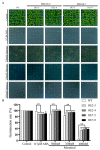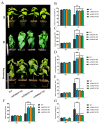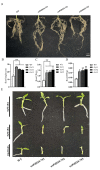Homologous Drought-Induced 19 Proteins, PtDi19-2 and PtDi19-7, Enhance Drought Tolerance in Transgenic Plants
- PMID: 35328791
- PMCID: PMC8954995
- DOI: 10.3390/ijms23063371
Homologous Drought-Induced 19 Proteins, PtDi19-2 and PtDi19-7, Enhance Drought Tolerance in Transgenic Plants
Erratum in
-
Correction: Wu et al. Homologous Drought-Induced 19 Proteins, PtDi19-2 and PtDi19-7, Enhance Drought Tolerance in Transgenic Plants. Int. J. Mol. Sci. 2022, 23, 3371.Int J Mol Sci. 2022 Dec 16;23(24):16023. doi: 10.3390/ijms232416023. Int J Mol Sci. 2022. PMID: 36555869 Free PMC article.
Abstract
Drought-induced 19 (Di19) proteins play important roles in abiotic stress responses. Thus far, there are no reports about Di19 family in woody plants. Here, eight Di19 genes were identified in poplar. We analyzed phylogenetic tree, conserved protein domain, and gene structure of Di19 gene members in seven species. The results showed the Di19 gene family was very conservative in both dicotyledonous and monocotyledonous forms. On the basis of transcriptome data, the expression patterns of Di19s in poplar under abiotic stress and ABA treatment were further studied. Subsequently, homologous genes PtDi19-2 and PtDi19-7 with strong response to drought stress were identified. PtDi19-2 functions as a nuclear transcriptional activator with a transactivation domain at the C-terminus. PtDi19-7 is a nuclear and membrane localization protein. Additionally, PtDi19-2 and PtDi19-7 were able to interact with each other in yeast two-hybrid system. Overexpression of PtDi19-2 and PtDi19-7 in Arabidopsis was found. Phenotype identification and physiological parameter analysis showed that transgenic Arabidopsis increased ABA sensitivity and drought tolerance. PtDi19-7 was overexpressed in hybrid poplar 84K (Populus alba × Populus glandulosa). Under drought treatment, the phenotype and physiological parameters of transgenic poplar were consistent with those of transgenic Arabidopsis. In addition, exogenous ABA treatment induced lateral bud dormancy of transgenic poplar and stomatal closure of transgenic Arabidopsis. The expression of ABA/drought-related marker genes was upregulated under drought treatment. These results indicated that PtDi19-2 and PtDi19-7 might play a similar role in improving the drought tolerance of transgenic plants through ABA-dependent signaling pathways.
Keywords: ABA; PtDi19-2; PtDi19-7; drought stress; lateral bud dormancy; stomatal closure.
Conflict of interest statement
The authors declare that they have no conflict of interest.
Figures










References
-
- Wang Z., Wang F., Hong Y., Yao J., Ren Z., Shi H., Zhu J.-K. The Flowering Repressor SVP Confers Drought Resistance in Arabidopsis by Regulating Abscisic Acid Catabolism. Mol. Plant. 2018;11:1184–1197. doi: 10.1016/j.molp.2018.06.009. - DOI
MeSH terms
Substances
Grants and funding
LinkOut - more resources
Full Text Sources
Miscellaneous

